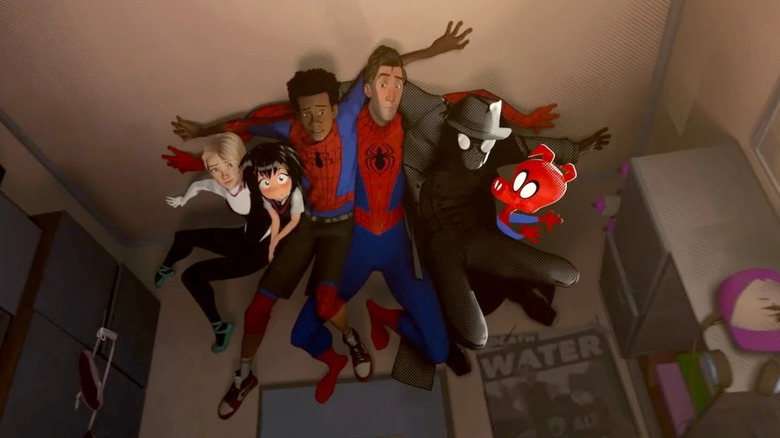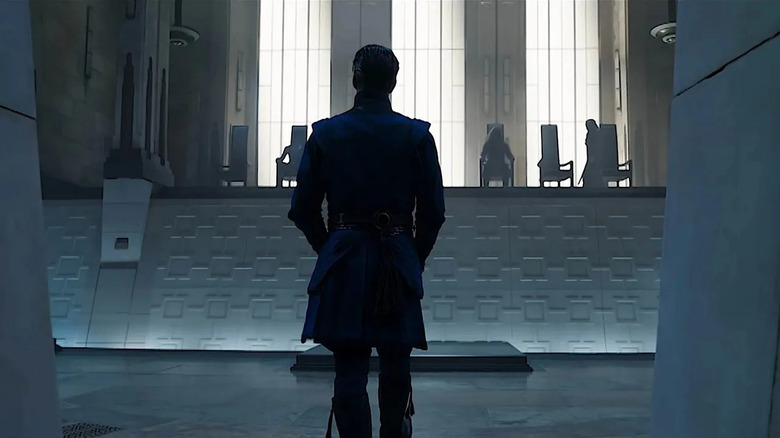Doctor Strange's Multiverse Of Madness Isn't Nearly As Impressive As Miles Morales' Spider-Verse
Warning: This article contains MAJOR SPOILERS for "Doctor Strange in the Multiverse of Madness."
"Doctor Strange in the Multiverse of Madness" finally brings the concept of the multiverse to the MCU after a long lead-up that sort of started in "WandaVision" (until Ralph Bohner ruined that) and then carried over to the surprisingly great "What If...?" series. The film not only shows us other universes with their own cool characters, but does so in a way that serves to further the story of the Stephen Strange of our own universe. According to Kevin Feige, this movie's exploration of the multiverse is even meant to bring us into "the next step in the evolution of the MCU."
And yet, the end result is kind of a disappointment. While Sam Raimi does deliver on the horror front — he makes this the most gruesome film in the MCU with some truly scary sequences — the multiverse itself feels very superficial, especially compared to other recent movies dealing with the multiverse.
Indeed, "Doctor Strange in the Multiverse of Madness" may involve the multiverse more than "Spider-Man: No Way Home," but it pales in comparison to the animated wonders of the Spider-Verse from "Spider-Man: Into the Spider-Verse." Somehow, that movie has just gotten better and more impressive with every movie that tries and fails to capture its brilliance.
A multiverse of visuals
For a movie with the word "multiverse" in its title, we spend rather little time actually exploring different universes, with 95% of the film's runtime spent in the main universe of Earth-616 and Earth-838. But when we do get some universe-hopping, the film finally attempts to fulfill the colorful, imaginative promises of the multiverse, to mixed results.
When America Chavez and Doctor Strange escape Earth-616 and Wanda's attacks, they end up going through many, many universes in a very quick montage. Most of them look just like New York but with a different color palette like this was the vastly underrated NBC show "Awake," but a few look quite interesting, like what seems like a "Waterworld" universe, a Minecraft universe made of cubes, one full of dinosaurs, a black-and-white noir universe, an animated one and even a universe where everyone is a blob of paint.
The problem is that these universes are shown in rapid blink-and-you'll-miss-them succession, more of a visual gag than an extension of the plot — almost like the movie was treating it as a chore to be done with as soon as possible. Is the universe with a dinosaur a modern world where dinosaurs created civilizations and became advanced or just a universe set in the Jurassic period? Did they actually go to a "Waterworld" universe or just travel to the bottom of the ocean? We never find out because the film is not interested in making its multiverse a lived-in place or even a place worth spending a little time in. The one thing we actually learn is different in one of these universes is the existence of pizza balls, which is more likely to become a new food option at a theme park than it is to be of any meaning to the future of Doctor Strange.
This is the exact opposite approach from "Into the Spider-Verse," which also showed different universes via quick scenes but actually made an effort to use the medium of animation to properly show how visually distinct every universe is — and actually show more than a couple of frames of each universe. The film also made it a point to use its alternate universe to develop Miles' story by showing us, and him, that he is not alone, because there are people in every conceivable universe that understand what he's gone through.
A multiverse of cameos
Of course, a big appeal of "Doctor Strange in the Multiverse of Madness" is the cool cameos of known actors and characters, and the film does give us the most explicit form of fan-casting yet in John Krasinski as Reed Richards, as well as a very cool and geeky moment for '90s kids in bringing back the 1997 "X-Men" cartoon theme back. It also follows the central idea of "What If...?" showing alternate versions of characters we know like Captain Carter and a new Captain Marvel.
And yet, The Illuminati, the big centerpiece of the film (cameo-wise), bite the dust in a gnarly and metal way. As cool as the scene when they all die is, it makes their appearance feel empty and meaningless, as we also don't get any insight into who this universe's version of these characters are. They also don't matter at all to Strange's story since he's never met a mutant or an inhuman before, and he never met Peggy Carter, and the one person in that universe to convey information useful to the plot is Mordo, who we've already seen in the first film.
This is far from the groundbreaking excitement of seeing Peter 2 and Peter 3 in "No Way Home," a movie that actually helped give closure to two other franchises. It is also far from the way "Into the Spider-Verse" fulfilled the promise of an infinite multiverse full of possibilities by showing us not one, not two, but five uniquely different Spider-Men from vastly different universes, each with their own animation style that is carried over the entire movie — not just when we see them in their own universes.
And these Spider-Men are more than just cameos, they are integral to the plot and to Miles' story. Spider-Ham saying that he is actually a spider bitten by a pork, and Gwen telling how Peter Parker died in her universe, are not just fun alternate facts, but they serve to compliment the film's central theme: you are not alone, and anyone can wear the mask.
Also, if we go strictly by which movie has the coolest fan service cameo, nothing can top "Into the Spider-Verse" giving us the actual Spider-Man pointing meme in the film itself, rather than during a promotional photo session.


